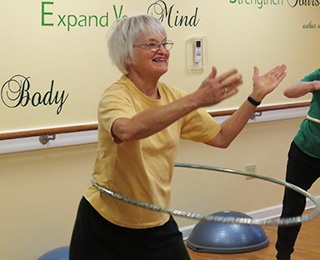Published: November 17, 2016
 In my late 20s I fell in love with running. I felt fit, physically and mentally. Never fast, I was always faithful to running at least a couple miles a day. But by my early 50s, my clothes began to feel tight, so I ran longer and further. Still the pounds kept coming.
In my late 20s I fell in love with running. I felt fit, physically and mentally. Never fast, I was always faithful to running at least a couple miles a day. But by my early 50s, my clothes began to feel tight, so I ran longer and further. Still the pounds kept coming.
When I finally got on a scale I was shocked to discover I had gained almost 15 pounds.
It was time to take action. I put aside my running shoes and signed up for a 3-month “circuit training” program that included different speeds, movements and weights. I attended nutrition classes and learned about the benefits of eating small amounts of healthy food throughout the day, starting with breakfast.
The pounds dropped. Once on my own I bought a hula-hoop and jump rope, pulled out the bike and hand weights, revisited yoga and returned to running. I have added new twists to running, such as 10-20-30 training (run slowly for 30 seconds, moderately for 20, and sprint for 10) and I continue to mix up my exercise. A decade later, the pounds have stayed off.
Fitness Funk
Consider if you only read bestsellers or refuse to learn new computer programs or rarely wander outside of your neighborhood. Your mind would not be stretched and challenged.
Well, same theory applies to your body. According to Healthline:
“When you perform the same exercises repeatedly, they become easier over time. In fact, your body's nervous system, muscles, and other physiological systems can adapt to a workout routine in as little as six to eight weeks. Eventually, your workouts won't offer you much of a challenge. If you don't change up your routine, your fitness level will plateau.”
Engaging in a variety of exercise activities is also a way to make sure your fitness program includes aerobics, strength training and flexibility, which is often hard to do if you stick with just one activity.
Cross-training has many benefits.
“Cross-training is ideal for anyone, whether you're a beginner who wants to get in shape or an experienced exerciser looking to take your fitness to the next level,” Dr. Michael Smith tells WebMD.
“One of the most common mistakes people make with exercise is repeating the same routine week after week. To continue to improve your fitness level and reap all the benefits of regular exercise, you need to keep your body guessing. Cross training does this for you.
“When you do the same activity over and over, you also set yourself up for overuse injuries. Cross training helps solve this problem, too.”
Cross-training can make exercise more fun - think “variety is the spice of life.”
Taking a Zumba® or spinning class, both which are set to loud, spirited music, can make your spirits soar. Or traversing Lake Erie on a stand up paddle board or kayak can bring serenity and joy.
The novelty can also help break up the boredom that often comes from running the same route or exercising on the same machines.
Let’s Get Started
Before beginning a new exercise program, you may want to talk to your doctor.
The Mayo Clinic recommends you talk to your doctor if any of the following apply: heart disease; asthma or lung disease; type 1 or 2 diabetes; kidney disease; arthritis; or are being treated for cancer.
The American College of Sports Medicine recommends that you see your doctor before engaging in vigorous exercise if two or more of the following apply:
- You're older than 35 years.
- You have a family history of heart disease before age 60.
- You smoke or you quit smoking in the past six months.
- You don't normally exercise for at least 30 minutes, most days of the week.
- You're significantly overweight.
- You have high blood pressure or high cholesterol.
- You have type 1 or type 2 diabetes, or you have impaired glucose tolerance (also called prediabetes).
Now that you have a doctor’s OK, how do you design a cross-training program? You might consider hiring a personal trainer who can work one-on-one with you to create a program that fits your specific needs, interest and limitations. Check with your local fitness center or gym or the United States Registry of Exercise Professionals®
WebMD experts, using information from The Physician and Sportsmedicine journal, put together a sample cross-training routine for a week.
Session 1: Walk briskly for about 20 minutes, adding hand weights to increase the impact. Also do stretching for 5-10 minutes, then lift weights or use resistance bands for upper body strength for 20-30 minutes.
Session 2: Jog at a steady pace for 20 minutes; stretch for 5-10 minutes; do weight training or any other exercise that builds lower body strength for 30 minutes.
Session 3: Swim for 20-30 minutes; then do yoga, Pilates, dance, or another activity that enhances balance and flexibility, for 20-30 minutes.
Session 4: Use an exercise bike, rowing machine, or cross-country skiing machine for 20-30 minutes; stretch for 10 minutes.
Session 5: Walk briskly for 20 minutes; then train both your upper and lower body using weights or resistance bands for 20 minutes.
Session 6: Jog at a varied pace for 30 minutes; stretch for 10 minutes.
Session 7: Walk at a comfortable pace for 30-45 minutes; then do yoga or Pilates for 20-30 minutes.
Of course, you might not have access to a swimming pool or gym equipment, but this sample routine can help guide you. Don’t be afraid to try a new activity or class, just make sure the class is designed for beginners or all levels.
Or find a local club that includes learning a new activity, such as biking or sailing.
Spend an afternoon browsing the aisles of REI or your favorite sporting goods store for exercise ideas. Snowshoes? Rockclimbing? Hiking staffs? Exercise balls? Roller blades? Make sure you have the right shoes and other equipment needed for a safe experience.
Eventually you’ll come up with two to three activities that you enjoy and enhance your fitness. Just make sure the mix gives you the benefits of aerobics, strength training and flexibility.
Random Acts of Fitness
Look for opportunities to stretch and strengthen your body throughout the day.
When you visit an office or doctor’s building, take the stairs both ways.
Park your car as far away from a store entrance as you can.
Walk the dog at a normal pace, then speed up and run – if you and Fido are game.
Put on your favorite music and dance.
Hold onto the kitchen counter while cooking and stretch.
Consider purchasing a Fitbit or other fitness tracker to help motivate you to stay active throughout the day. Along with tracking “steps,” many of the trackers also track heart rate.
 Molly Kavanaugh frequently wrote about Kendal at Oberlin for the Cleveland Plain Dealer, where she was a reporter for 16 years.
Molly Kavanaugh frequently wrote about Kendal at Oberlin for the Cleveland Plain Dealer, where she was a reporter for 16 years.





